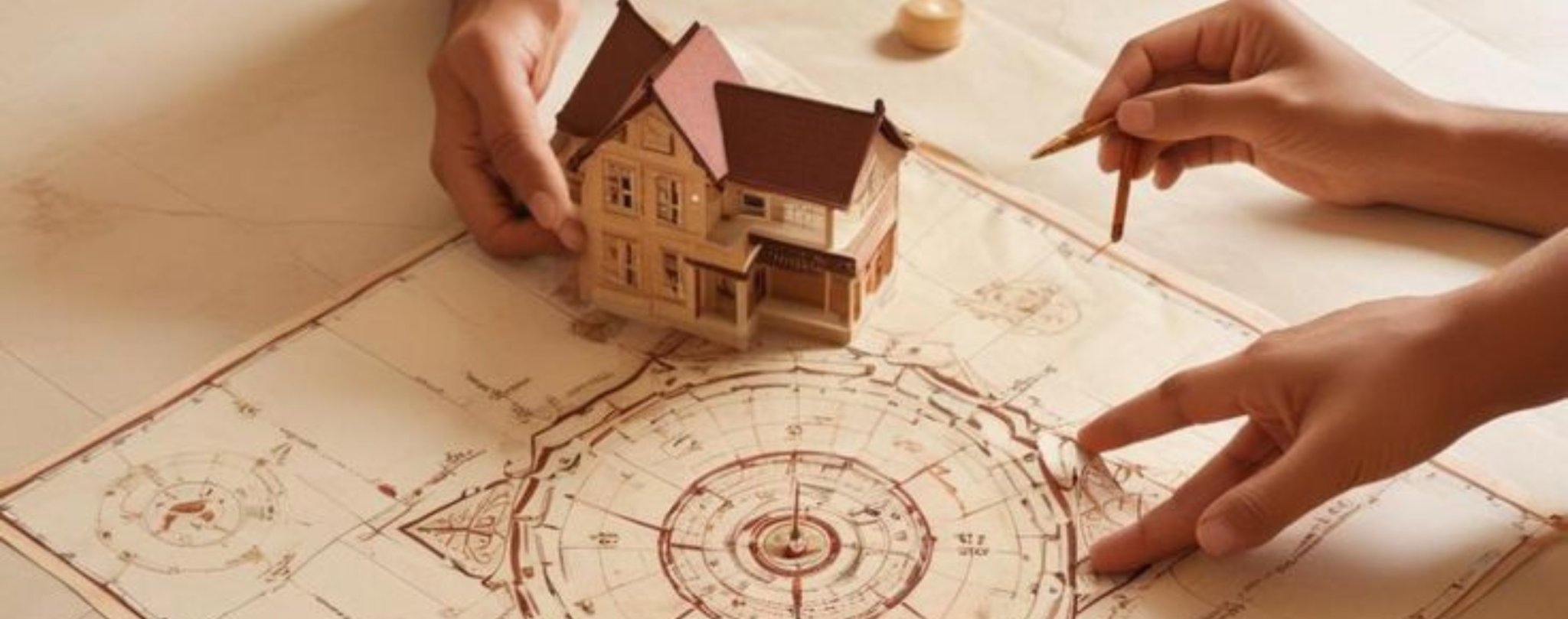
Vastu : Harmonizing Home and Life
Vastu is an ancient Indian architectural and design system that seeks to create harmony between the built environment and the natural world. It's based on the belief that the placement of structures, objects, and people can influence energy flow and well-being.
Key Concepts Of Vastu Include:
Energy balance: Vastu seeks to balance the five elements (earth, water, fire, air, and space) within a structure.
Positive energy flow: The placement of objects and furniture should promote the flow of positive energy throughout the space.
Avoidance of negative energy: Vastu identifies certain areas or placements that are believed to generate negative energy.
Directional alignment: Buildings and rooms should be aligned with the cardinal directions (north, south, east, west) to optimize energy flow.
Basic Vastu
Vastu Shastra is an ancient Indian system of architecture and design that aims to create harmony between a structure and its inhabitants.
Some basic principles of Vastu Shastra include:
- Room shape: Rooms should be square or rectangular.
- Room basics: Rooms should be bright, clean, airy, and well-lit.
- Home center: The center of the house should be empty.
- Water: Avoid keeping water features like aquariums, water fountains, or paintings depicting water.
- Dining table: The dining space should be near the kitchen, not the main door.
- Mirror placement: Avoid placing a mirror in the bedroom that reflects the sleeping couple.
- Orientation: The main entrance should face east or north.
- Living room: The living room should be in the northwest direction.
- Kitchen: The kitchen should ideally be in the southeast direction.
- Master bedroom: The master bedroom should be in the southwest direction.
- Kids’ room: The kids’ room should be in the southwest direction.
- Toilet: The toilet should be in the west or northwest direction.
- Overhead water tank: The overhead water tank should ideally be in the west or southwest direction.
Astro Vastu
Astro vastu is a synthesis of vastu shastra and astrology that evaluates vastu and birth charts at the individual level. An Astro vastu did not exist in the ancient writings. Back then, vastu consultants were practitioners of both astrology and vastu vidya, having studied both fields in depth. It has been observed that the impact of vastu varies among individuals. Different household members experience the vastu’s results differently. Thus, it is quite effective to use vastu shastra and astrology to solve difficulties on an individual basis. This tool is effectively used by AppliedVastu when practicing Vastu Shastra.
The core principles of Astro Vastu:
The area of occult science known as Astro Vastu is where planets are charted and directions are correlated. Every sign of the zodiac is associated with a specific direction. Each of the nine planets in Vedic astrology also governs a particular direction. This relationship between vastu and individual birth charts was deciphered by Astro Vastu.
Sun: East Moon: North West
Jupiter: North East Mercury: North
Venus: South East Mars: South
Saturn: West
North Lunar Node (Rahu): South West
South Lunar Node (Ketu): Center of house
Home & Flat Vastu
Vastu Shastra is an ancient Indian architectural system that focuses on the flow of energy in a home to promote prosperity, health, and well-being.
Here are some Vastu Shastra tips for flats and apartments:
- Entrance: Keep the entrance clean, well-lit, and free of clutter to attract good energy.
- Doors and windows: Each floor should have an even number of doors and windows, but not a number ending in zero.
- Kitchen: The gas stove should be in the southeast corner of the kitchen, and the cook should face east. The sink should be in the northeast or north direction of the kitchen. Avoid placing the sink and stove next to each other.
- Storage: Store grains and other items in the west or south walls of the kitchen.
- Compass: Use a compass to determine the directions of your home.
Shop & Office Vastu
Vastu Shastra is an ancient Indian science that aims to create positive energy and harmony in living and working spaces. It can help improve the success and prosperity of shops and offices by:
- Attracting positive energy: Vastu Shastra can help create a positive environment that attracts prosperity and good fortune.
- Improving productivity: Vastu Shastra can help create an atmosphere that promotes employee well-being and productivity.
- Leaving a positive impression: Vastu Shastra can help create a strategic commercial space that leaves a positive impression on customers
Here are some Vastu Shastra tips for shops and offices:
- Location: Choose a regular-shaped site, preferably square or rectangular.
- Entrance: Design a well-designed entrance to draw customers in.
- Cash counter: Place the cash counter so that it opens towards the north.
- Cash box: Keep the cash box safe and secure, and have some cash inside it.
- Office desk: Ensure that your table or desk is rectangular shaped, and made from superior quality wood.
- Finished goods: Place finished goods in the north-west direction to ensure they are sold.
- Financial documents: Lock away important financial documents in a safe constructed in the south-west zone of the office.
- Paint colors: Paint south-facing shops in light colors like orange, yellow, pink, or light green.
45 devta
Here among 45 deities, 32 gods are shown in the external closures and 13 deities in the internal closures. They rule various aspects of our life according to their inherent qualities. The core theory of any vastu planning & design stands above Vastu Purusha Mandala.
Still, the Vastu Purusha Mandala is more than just a massive image surrounded by numerous squares and cells. It illustrates the intersection and the movement of energy currents within the human body, as was previously mentioned. We know that this energy current has a significant influence on our mind, body, and soul because of vastu shastra. The building’s occupants will be able to feel the impact once it is finished. The square in the accompanying diagram represents a 360-degree chart. The diagram is split up into nine squares, or 9*9=81 sections. This diagram shows 44 deities in their designated locations, with Brahma at the center, known as Brahmasthan.
13 of the 45 gods are depicted within, while the other 32 gods are displayed outside. They govern several facets of our existence based on their innate characteristics. Above the Vastu Purusha Mandala is the fundamental theory of all vastu planning and design. The layout of each room in the house must take into account the traits of each of the 45 deities on the Vastu Purusha Mandala’s energy fields. Manduka/Chandita Mandala is a Vastu Purusha Mandala consisting of 8*8=64 squares. On the other hand, the diagram known as the Paramasaayika Mandala depicts 9*9=81 courts. The major audience for these two 9*9 and 8*8 grids is vastu practitioners. The Paramasaayika Mandala was used by the Vastu experts to design palaces and residences, whereas the Manduka Mandala was utilized to design temples.
Color Therapy
In Vastu Shastra, color therapy is the idea that colors can balance the body, mind, and spirit by stimulating energy in different spaces. According to Vastu, the right colors in the right direction can positively influence the home and its inhabitants.
- Living room: Bright colors like yellow, green, and blue can promote harmony and social interaction. Dark and intense colors can make the space seem smaller and less welcoming.
- Study room: White, yellow, and green can help boost energy levels and concentration.
- Direction of a student’s chair: The chair should preferably face North or East, as these directions are believed to bring concentration and focus.
Some say that the effects of colors may range from person to person. For example, colors that are calm and soothing for some may be depressing or anxiety-inducing to others.
Ideal colours for different areas of the house:
- Ceilings should always be white or in off-white colour, as it reflects light.
- Natural shades like green (which symbolises life and growth), yellow (stability), orange (cheerfulness) and blue (aids concentration), are recommended for children’s rooms.
- For the temple area, it is best to use purple or lavender, as it is associated with spirituality, peace and wisdom.
- Orange evokes excitement and enthusiasm and is apt for an exercise room.
- Avoid excessive use of black and grey, as it can give a depressing feel.
- Red helps in increasing appetite. So, add subtle touches of red on the dining table, with red flowers or red table linen.
- Bedrooms should be done up in soothing colours, such as pink, peach, light yellow, green and other light colours.
- The colour pink is associated with romance. Similarly, red is the colour of passion but avoid too much of it in the bedroom, as it leads to aggression.
